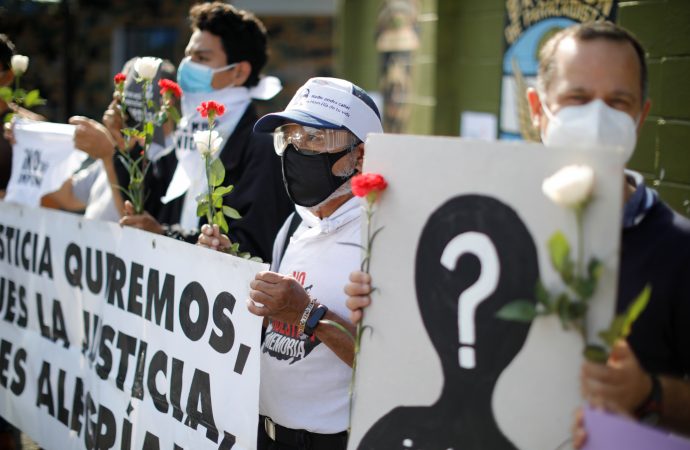The burble of water is the loudest sound most will hear along this lush patch of land near the Sumpul River, which divides northern El Salvador from Honduras. But what Noe Guardado still hears in his head, what drowns out the sounds of the water are the sounds of the helicopters, the gunfire that trapped a population of some 650 unarmed civilians May 14, 1980, along the normally tranquil riverbed.
“When I come here, I see those who were left behind and I wish … I wish I could bring them back to life,” Guardado said in a May 14 interview with Catholic News Service.
Now a grandfather in his 70s, he was one of hundreds of pilgrims who attended the 41st anniversary commemorations of what has become known as the Sumpul River massacre.
Survivors say on May 13, 1980, the day before the massacre, hundreds of armed soldiers on the Salvadoran side of the river began invading towns around the Sumpul (pronounced soom-pool), driving terrified residents, suspected of being sympathizers of leftist rebels, toward the river, toward a demilitarized zone known as Las Aradas, a hamlet on the riverbank where locals went for refuge.
In what is believed to have been a coordinated military effort, soldiers on the Honduran side simultaneously began combing for Salvadorans who had been hiding in the brush near their side of the border, driving them, too, toward the Sumpul.
At 7 a.m. the next day, when soldiers on both sides had trapped a large group of peasants in a perimeter, they opened fire on them. Some died by bullets launched from two military helicopters as members of a paramilitary group opened fire on those on the ground. With the water of the river running high that day, even those who managed to dodge the bullets were carried to their death in the current.
“The powerful would say ‘communists, communists,'” to justify the attacks on the civilians, many who had joined unions, seeking fair wages and working conditions during a time of great disparity, said Bishop Oswaldo Escobar Aguilar of Chalatenango. Along with half a dozen priests, the prelate concelebrated a Mass remembering the dead as faith-filled Christians, catechists and Catholic ministers, not rebels.
The Catholic Church, he said, is committed to recouping the historic memory of events such as the Sumpul River massacre, shedding light on the truth, not on the defamations that painted victims, many of them children, as terrorist threats.
For years, hundreds have flocked to the remote hamlet, tracing the steps of the victims into Las Aradas, accessible only by foot or horse. Lack of easy access to the site where the massacre took place helped soldiers hide evidence of the atrocities they committed. Some included the bludgeoning of pregnant women and their unborn children, killed with bayonets, as well as rapes in daylong frenzy of violence.
A Franciscan Capuchin from New York working in Honduras, Father Earl Gallagher, tended to surviving victims shortly after the incident. Gallagher, known as “Padre Beto,” told The New York Times he had visited the river on the Honduran side a day after the victims began trickling in, and he said, “there were so many vultures picking at the bodies in the water that it looked like a black carpet,” according to a June 8, 1981, story in the newspaper.
Survivors — and those like Guardado, who, by his own admission, was a rebel fighter who happened to be hiding in the mountains that day — say it’s hard to erase the images. Even if you didn’t witness them, there’s an eerie feeling when you see actors pushing women and children down to the ground with the butt of rifle, pretend-killing those who cry.
Irish Franciscan Father Brendan Forde, who works with the rural communities where events took place, urged the hundreds who attended the commemorations as a type of pilgrimage to remember that they were standing on hallowed ground.
“Blood was spilled here. It’s not merely a symbol,” he said. “Where our feet are, this is the place.”
Like many crimes, big and small in El Salvador, no one has ever faced consequences. In a news conference during the commemoration, survivors asked for justice, saying that even though a complaint was filed in 1992, the attorney general’s office has refused to investigate the crime. They said they worry that impunity will continue under President Nayib Bukele, who denigrated the compromises made in 1992 peace accords that brought El Salvador’s 12-year civil war to an end.
“We don’t seek vengeance, we instead aspire toward a national reconciliation,” one that, through a renewed investigation, will finally tell the world what happened, ask for forgiveness and guarantee moral and material reparations, the Association of Survivors of the Sumpul River and other Massacres in Chalatenango said in a news release.
The bishop asked those who attended to consider what Las Aradas could become on the 50th anniversary of the massacre, nine years into the future. Many of them said they wanted to see a sanctuary, a place to reflect, a natural park.
“I would love to see a place where children could cry and laugh with joy, something beautiful,” said Forde. “Let’s not build a big church. Let’s have a place where people can come together to celebrate, especially children, a place where they can laugh and cry in peace, because many (during the massacre) died crying (of terror).”

